| Revision as of 14:08, 28 February 2024 edit2.96.202.131 (talk) muscle descriptionTags: Reverted Visual edit← Previous edit | Revision as of 14:12, 28 February 2024 edit undoFilmssssssssssss (talk | contribs)Extended confirmed users, Pending changes reviewers, Rollbackers34,629 editsm Reverted 1 edit by 2.96.202.131 (talk) to last revision by TraumnovelleTags: Twinkle UndoNext edit → | ||
| Line 17: | Line 17: | ||
| | kc_std = http://www.cku.org.cn/breed/dog/253 | | kc_std = http://www.cku.org.cn/breed/dog/253 | ||
| }} | }} | ||
| The '''Pug''' is a ] originally from China, with physically distinctive features of a wrinkly, short-muzzled face, and curled tail. The breed has a fine, glossy coat that comes in a variety of colors, most often ] (light brown) or ], and a compact, square body with |
The '''Pug''' is a ] originally from China, with physically distinctive features of a wrinkly, short-muzzled face, and curled tail. The breed has a fine, glossy coat that comes in a variety of colors, most often ] (light brown) or ], and a compact, square body with well developed and thick muscles all over the body. | ||
| Pugs were brought from China to Europe in the sixteenth century and were popularized in Western Europe by the ] of the Netherlands, and the ].<ref name="Pugs in public" /> In the United Kingdom, in the nineteenth century, ] developed a passion for Pugs which she passed on to other members of the royal family. | Pugs were brought from China to Europe in the sixteenth century and were popularized in Western Europe by the ] of the Netherlands, and the ].<ref name="Pugs in public" /> In the United Kingdom, in the nineteenth century, ] developed a passion for Pugs which she passed on to other members of the royal family. | ||
Revision as of 14:12, 28 February 2024
For other uses, see Pug (disambiguation).Dog breed
| Pug | |||||||||||||
|---|---|---|---|---|---|---|---|---|---|---|---|---|---|
 A fawn-colored pug, the most common coloring A fawn-colored pug, the most common coloring | |||||||||||||
| Origin | China | ||||||||||||
| |||||||||||||
| Dog (domestic dog) | |||||||||||||
The Pug is a breed of dog originally from China, with physically distinctive features of a wrinkly, short-muzzled face, and curled tail. The breed has a fine, glossy coat that comes in a variety of colors, most often fawn (light brown) or black, and a compact, square body with well developed and thick muscles all over the body.
Pugs were brought from China to Europe in the sixteenth century and were popularized in Western Europe by the House of Orange of the Netherlands, and the House of Stuart. In the United Kingdom, in the nineteenth century, Queen Victoria developed a passion for Pugs which she passed on to other members of the royal family.
Pugs are known for being sociable and gentle companion dogs. The American Kennel Club describes the breed's personality as "even-tempered and charming". Pugs remain popular into the twenty-first century, with some famous celebrity owners. Pugs are susceptible to various health issues due to their bred traits.
Etymology
The Oxford English Dictionary has the word 'pug' as in the dog breed being descended from the meaning of 'A dwarf animal, an imp, etc.'. Since the late 16th century the term 'pug' has been used in English to describe squirrels, hares, foxes, ferret, salmon, sheep, and monkeys. The first attestation of 'Pug-dog' is in 1749. The OED also notes it may be related to a now obsolete term of endearment for a person or animal.
Description
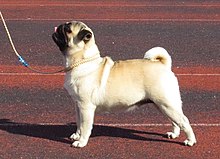
Physical characteristics
While the Pugs that are depicted in eighteenth century prints tend to be long and lean, modern breed preferences are for a square cobby body, a compact form, a deep chest, and well-developed muscle. Their smooth and glossy coats can be fawn, apricot fawn, silver fawn, or black. The markings are clearly defined and there is a trace of a black line extending from the occiput to the tail. The tail normally curls tightly over the hip.
Pugs have two distinct shapes for their ears, "rose" and "button". "Rose" ears are smaller than the standard style of "button" ears, and are folded with the front edge against the side of the head. Breeding preference goes to "button" style ears.
Pugs' legs are strong, straight, of moderate length and are set well under. Their shoulders are moderately laid back. Their ankles are strong, their feet are small, their toes are well split-up, and their nails are black. The lower teeth normally protrude further than their upper, resulting in an under-bite.
Temperament
The American Kennel Club says the motto of the breed is the Latin phrase multum in parvo, or "much in little" or "a lot of dog in a small space". Pugs tend to be intuitive and sensitive to the moods of their owners and are usually eager to please them. Pugs are playful and thrive on human companionship. They also tend to have a snoozy nature and spend a lot of time napping. Pugs are often called "shadows" because they follow their owners around and like to stay close to the action, craving attention and affection from their owners.
-
 The breed has strong, straight legs set well under the body and a tail that curls over the hip.
The breed has strong, straight legs set well under the body and a tail that curls over the hip.
-
 Pure-bred pugs are known for their unique facial wrinkles.
Pure-bred pugs are known for their unique facial wrinkles.
-
 Fawn is the most common color for a pug, but the American Kennel Club also recognizes the color black. The Canadian Kennel Club recognizes the colors black, silver, apricot, and fawn.
Fawn is the most common color for a pug, but the American Kennel Club also recognizes the color black. The Canadian Kennel Club recognizes the colors black, silver, apricot, and fawn.
History
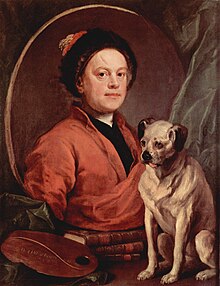
Chinese origins
Pugs were brought from China to Europe in the sixteenth century. Similar dogs were popular in the imperial court during the Song dynasty.
In ancient times, Pugs were bred to be companions for ruling families in China. The pet Pugs were highly valued by Chinese emperors, and the royal dogs were kept in luxury and guarded by soldiers. Pugs later spread to other parts of Asia. In Tibet, Buddhist monks kept Pugs as pets in their monasteries. The breed has retained its affectionate devotion to its owners since ancient times.
16th and 17th centuries
Pugs were popular at European courts, and reportedly became the official dog of the House of Orange in 1572 after a Pug named Pompey saved the life of the Prince of Orange by alerting him to the approach of assassins.
A Pug traveled with William III and Mary II when they left the Netherlands to accept the throne of England in 1688. During this period, the Pug may have been bred with the old type King Charles spaniel, giving the modern King Charles Spaniel its Pug-like characteristics.
The breed eventually became popular in other European countries as well. Pugs were painted by Goya in Spain, and in Italy they rode up front on private carriages, dressed in jackets and pantaloons that matched those of the coachman. They were used by the military to track animals and people, and were also employed as guard dogs.
18th century to 20th century

The English painter William Hogarth was the devoted owner of a series of Pugs. His 1745 self-portrait, which is now in London's Tate Gallery, includes his Pug, Trump. The Pug was also well known in Italy. In 1789, author Hester Piozzi wrote in her journal, "The little Pug dog or Dutch mastiff has quitted London for Padua, I perceive. Every carriage I meet here has a Pug in it."
The popularity of the Pug continued to spread in France during the eighteenth century. Before her marriage to Napoleon Bonaparte, Joséphine had her Pug Fortune carry concealed messages to her family while she was confined at Les Carmes prison, it having alone been given visiting rights.
In nineteenth-century England, the breed flourished under the patronage of Queen Victoria. Her many Pugs, which she bred herself, included Olga, Pedro, Minka, Fatima and Venus. Her involvement with dogs in general helped to establish the Kennel Club, which was formed in 1873. Queen Victoria favored apricot and fawn colors. Her passion for Pugs was passed on to many other members of the royal family, including her grandson King George V and his son King Edward VIII. Many responded to the breed's image of anti-functionalism and diminutive size during this period.
In paintings and engravings of the 18th and 19th centuries, Pugs usually appear with longer legs and noses than today, and sometimes with cropped ears. The modern Pug's appearance probably changed after 1860 when a new wave of Pugs were imported directly from China. These Pugs had shorter legs and the modern-style Pug nose. The British aristocrat Lady Brassey is credited with making black Pugs fashionable after she brought some back from China in 1886.
Pugs arrived in the United States during the nineteenth century and were soon making their way into the family home and the show ring. The American Kennel Club recognized the breed in 1885. The Pug Dog Club of America was founded in 1931 and was recognized by the American Kennel Club that same year. In 1981, the Pug Dhandys Favorite Woodchuck won the Westminster Kennel Club Dog Show in the United States, the only Pug to have won there since the show began in 1877.
21st century


The World Champion – or Best in Show – at the 2004 World Dog Show held in Rio de Janeiro, was a Pug named Double D Cinoblu's Masterpiece.
Retro Pugs
The breeding trend of Pugs led to shorter muzzles and shorter legs over time, with the dogs susceptible to some health issues. In 2023, the Netherlands placed limitations on the breeding of various short-faced breeds, including the conventional Pug. Since around 2006 there has been a counter-trend in some countries to breed "retro pugs". Breeders that pursue this change of the breed aim for longer snouts, less protruding eyes, as well as straight legs and less facial wrinkles.
Health issues
Brachycephaly
Since Pugs lack longer snouts and prominent skeletal brow ridges, they are susceptible to eye injuries such as proptosis, scratched corneas, and painful entropion. The shortened snout and pushed in face of the Pug is known as brachycephaly. Brachycephaly results in deformation of the upper airway tract and leads to obstruction of breathing. Effects of brachycephaly are stridor, stertorous breathing, emesis, skin fold dermatitis, brachycephalic airway obstructive syndrome, exophthalmos, pharyngeal gag reflex, cyanosis, and laryngeal collapse.
Other issues arising from brachycephaly are risk of complications whilst under anaesthesia, and hyperthermia – with the latter caused due to an inability to effectively reduce body temperature via panting. Their breathing problems can be worsened by the stresses of traveling in air cargo, which may involve high temperatures. Following the deaths of Pugs and other brachycephalic breeds, several airlines either banned their transport in cargo or enacted seasonal restrictions.
Obesity
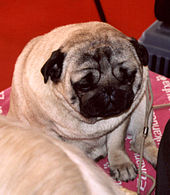
Research from the UK found that Pugs are more prone to obesity than other breeds: they are three times more likely to develop obesity and one of every five Pugs are diagnosed as obese in a year. Obesity should be considered a health priority in Pugs because of the high prevalence, associated health problems and reversible nature of the disorder.
Life expectancy
A study in the UK of veterinary records found the Pug to have a life expectancy of 7.65 years – far below the average of 11.23 years. A review of pet cemetery data in Japan found the Pug to have a life expectancy of 12.8 years – below the average of 13.7 years and lower than the average for small breeds.

Inbreeding depression
In 2008, an investigative documentary carried out by the BBC found significant inbreeding between pedigree dogs, with a study by Imperial College, London, showing that the 10,000 Pugs in the UK were so inbred that their gene pool was the equivalent of only 50 individual humans.
Other conditions
An abnormal formation of the hip socket, known as hip dysplasia, affected nearly 64% of Pugs in a 2010 survey performed by the Orthopedic Foundation for Animals; the breed was ranked the second worst-affected by this condition out of 157 breeds tested.
In a British study the Pug was found to be more susceptible to demodicosis. The prevalence of the condition in Pugs under 2 years was 1.9% compared to the 0.48% average and for Pugs over 4 years it was 0.2% compared to the 0.05% average, overall the Pug had a prevalence of 1% compared to the 0.17% average.
Pugs can suffer from necrotizing meningoencephalitis (NME), also known as Pug dog encephalitis (PDE), an inflammation of the brain and meninges. NME is not unique to Pugs and also occurs in other small dogs, such as the Yorkshire Terrier, Maltese, and Chihuahua. NME affects roughly 1–2% of all Pugs.
The Pug is prone to hemivertebrae. This condition can lead to pain as well as loss of function in the hind legs.
Birth and reproduction
Due to the relative size of neonatal skulls to the birth canal, Pugs are highly predisposed to cesarean births.
Historical depictions of pugs
-
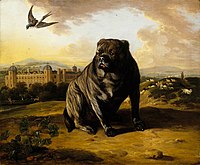 A Dutch Mastiff (called 'Old Vertue') with Dunham Massey in the Background" (Jan Wyck, 1700)
A Dutch Mastiff (called 'Old Vertue') with Dunham Massey in the Background" (Jan Wyck, 1700)
-
 A portrait of Princess Ekaterina Golitsyna by Louis-Michel van Loo (1759)
A portrait of Princess Ekaterina Golitsyna by Louis-Michel van Loo (1759)
Moscow, Pushkin Museum of Fine Arts -
 Children of the Marquis de Béthune with a Pug, 1761
Children of the Marquis de Béthune with a Pug, 1761
-
 A male Pug, 1802
A male Pug, 1802
-
 Portrait of Sylvie de la Rue, circa 1810
Portrait of Sylvie de la Rue, circa 1810
-
 Young Lady in a Boat with a Pug by James Tissot, 1870
Young Lady in a Boat with a Pug by James Tissot, 1870
-
Engraving of the Pugs "Punch and Tetty" from the 1859 book "The Dog in Health and Disease"
-
Pug from 1915.
-
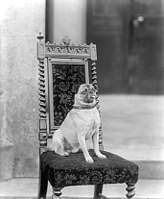 Pug photo, ca 1900. Note its small head and long legs.
Pug photo, ca 1900. Note its small head and long legs.
-
 A Pug by Carl Reichert. (1836–1918)
A Pug by Carl Reichert. (1836–1918)
In popular culture
The breed became iconic in India, as it was featured as the mascot in a series of Vodafone (formerly Hutchison Essar) advertising commercials directed by Prakash Varma. The Pug that was predominantly featured in the commercials was Cheeka. The advertisement campaign was followed by a rise in the popularity of Pugs in India, and the sale of Pugs more than doubled within months, with prices for Pugs rising considerably. A few other adverts also appeared in the following months, inspired by the idea of a dog following a boy.
In Jane Austen's 1814 novel, Mansfield Park, Lady Bertram, the hero's mother, owned a pet Pug and was "thinking more of her Pug than her children".
The 1989 film The Adventures of Milo and Otis features a Pug named Otis, known as "Poosky" in its original 1986 Japanese version The Adventures of Chatran.
The Men in Black film series features Frank, a fictional talking Pug portrayed by animal actor Mushu.
See also
Notes
- 1. The Japanese study reviewed cemetery data which is unlikely to have any records of still-births and altricial deaths whilst a veterinary clinic likely would have data on these.
References
- ^ "American Kennel Club - Pug History". AKC.org. American Kennel Club. Retrieved 19 August 2006.
- ^ Farr, Kendall; Montague, Sarah (1999). Pugs in Public. New York: Stewart, Tabori & Chang, a division of U.S. Media Holdings. ISBN 1-55670-939-0.
- ^ September Morn (2010). Our Best Friends: The Pug. Pittsburgh: ElDorado Ink. pp. 11, 14–15. ISBN 9781932904710. Retrieved 2 April 2015.
- ^ "American Kennel Club - Pug". AKC.org. Retrieved 14 October 2008.
- O’Neill, Dan G.; Sahota, Jaya; Brodbelt, Dave C.; Church, David B.; Packer, Rowena M.A.; Pegram, Camilla (18 May 2022). "Health of Pug dogs in the UK: disorder predispositions and protections". Canine Medicine and Genetics. 9 (1): 4. doi:10.1186/s40575-022-00117-6. ISSN 2662-9380. PMC 9115981. PMID 35581668.
- "pug, n.²". Oxford English Dictionary. Oxford University Press. 2 March 2023. doi:10.1093/oed/7135363746.
- Color: The colors are fawn or black. The fawn color should be decided so as to make the contrast complete between the color and the trace and mask.
- "Ears". Pugs.org. Pug Dog Club of America. Archived from the original on 15 October 2008. Retrieved 14 October 2008.
- Belmonte, Brenda (2004). The Pug Handbook. New York: Barron's Educational Series Inc. p. 13. ISBN 9780764124884.
pug craves attention.
- Collier, V. W. F. (1921). Dogs of China & Japan, in nature and art. W. Heinemann, London. p. 147.
The Lo-Chiang dog was a "pai" dog and consequently small, "short-headed," and "short-legged" before A.D. 1000. It was very possibly the Chinese Pug and appears to have been fashionable at the Chinese court from the beginning of the eighth century to the middle of the eleventh century possibly even to the removal of the capital from Hsianfu to Peking, about A.D. 1153.
- Moffat, Norma (27 March 2006). Cavalier King Charles Spaniel: Your Happy Healthy Pet (2nd ed.). Howell Book House. p. 19. ISBN 0-471-74823-4.
- William Hogarth. The Painter and his Pug, 1745. Tate Gallery, London, England. www.tate.org.uk. Retrieved 9 April 2013.
- Maggitti, Phil (2000). Pugs: Everything about Purchase, Care, Nutrition, Behavior, and Training. Barron's Educational Series. p. 10. ISBN 978-0-7641-1045-0. Retrieved 17 January 2010.
pug.
- Wilhelmina Swainston-Goodger (5 March 2013). The Pug-Dog - Its History and Origin. Read Books Limited. pp. 50–. ISBN 978-1-4474-8817-0.
- Katharine Macdonogh (August 1996). "Prison Pets in the French Revolution". History Today. 46.
- "Royal Collection - The Duke of York holding a pug". royalcollection.org.uk.
- Yang, C. (2012). Culture in Miniature: Toy Dogs and Object Life. Eighteenth Century Fiction, 25(1), 139-174.
- Cunliffe, Juliette. "History of the Pug". DogChannel.com. Archived from the original on 13 May 2016. Retrieved 26 December 2009.
- "Interview with Ann Joe Sampaio, owner of Double D Cinoblu's Masterpiece". World Dog Show 2015. 27 February 2014. Archived from the original on 26 April 2016. Retrieved 18 April 2016.
- "DOUBLE D CINOBLU'S MASTERPIECE". Pedigree Online. Retrieved 19 February 2024.
- "Netherlands puts further limits on breeding flat-faced dogs". NL Times. 24 August 2023. Retrieved 15 December 2023.
- Retro Pug, Zooplus magazine, accessed: 5 August 2021.
- Qualzucht im Fokus: Der Mops, Welttierschutz.org, 22 August 2019.
- Waterfield, Bruno (23 January 2023). "Dutch ban on pugs and French bulldogs puts owners' noses out of joint". The Times. Retrieved 6 February 2024.
- Knecht, C. D. (1979). Upper airway obstruction in brachycephalic dogs. Compend Contin Educ Pract Vet, 1, 25-31.
- Hendricks, Joan C. (1992). "Brachycephalic Airway Syndrome". Veterinary Clinics of North America: Small Animal Practice. 22 (5). Elsevier BV: 1145–1153. doi:10.1016/s0195-5616(92)50306-0. ISSN 0195-5616. PMID 1523786.
- TC, Amis; C, Kurpershoek (1986). "Pattern of breathing in brachycephalic dogs". American Journal of Veterinary Research. 47 (10). Am J Vet Res: 2200–2204. ISSN 0002-9645. PMID 3777646. Retrieved 6 February 2024.
- Hendricks, J. C.; Kline, L. R.; Kovalski, R. J.; O'Brien, J. A.; Morrison, A. R.; Pack, A. I. (1 October 1987). "The English bulldog: a natural model of sleep-disordered breathing". Journal of Applied Physiology. 63 (4). American Physiological Society: 1344–1350. doi:10.1152/jappl.1987.63.4.1344. ISSN 8750-7587. PMID 3693167.
- Hendricks, Joan C. (1992). "Brachycephalic Airway Syndrome". Veterinary Clinics of North America: Small Animal Practice. 22 (5). Elsevier BV: 1145–1153. doi:10.1016/s0195-5616(92)50306-0. ISSN 0195-5616. PMID 1523786.
- Meola, Stacy D. (2013). "Brachycephalic Airway Syndrome". Topics in Companion Animal Medicine. 28 (3). Elsevier BV: 91–96. doi:10.1053/j.tcam.2013.06.004. ISSN 1938-9736. PMID 24182996.
- Lundgrun, Becky (26 June 2006). "Reverse Sneezing (Pharyngeal Gag Reflex)". VeterinaryPartner.com. Retrieved 26 December 2009.
- Sebbag, Lionel; Sanchez, Rick F. (2023). "The pandemic of ocular surface disease in brachycephalic dogs: The brachycephalic ocular syndrome". Veterinary Ophthalmology. 26 (S1): 31–46. doi:10.1111/vop.13054. ISSN 1463-5216. PMID 36585820.
- Hobi, Stefan; Barrs, Vanessa R.; Bęczkowski, Paweł M. (16 June 2023). "Dermatological Problems of Brachycephalic Dogs". Animals. 13 (12). MDPI AG: 2016. doi:10.3390/ani13122016. ISSN 2076-2615. PMC 10294810. PMID 37370526.
- Gruenheid, Michaela; Aarnes, Turi K.; McLoughlin, Mary A.; Simpson, Elaine M.; Mathys, Dimitria A.; Mollenkopf, Dixie F.; Wittum, Thomas E. (1 August 2018). "Risk of anesthesia-related complications in brachycephalic dogs". Journal of the American Veterinary Medical Association. 253 (3). American Veterinary Medical Association (AVMA): 301–306. doi:10.2460/javma.253.3.301. ISSN 0003-1488. PMID 30020004. S2CID 51676839.
- Ewers Clark, Anna (22 December 2022). "Heatstroke and brachycephalic dogs – is there an increased risk?". Veterinary Evidence. 7 (4). doi:10.18849/ve.v7i4.534. ISSN 2396-9776.
- "Air Travel and Short-Nosed Dogs FAQ". American Veterinary Medical Association. Retrieved 7 July 2014.
- Haughney, Christine (6 October 2011). "Banned by Many Airlines, These Bulldogs Fly Private". The New York Times. Archived from the original on 7 October 2011. Retrieved 7 July 2014.
- "Research shows Pugs at highest risk of obesity". British Small Animal Veterinary Association. 27 January 2023. Retrieved 6 February 2024.
- O’Neill, Dan G.; Darwent, Elisabeth C.; Church, David B.; Brodbelt, Dave C. (10 June 2016). "Demography and health of Pugs under primary veterinary care in England". Canine Genetics and Epidemiology. 3 (1): 5. doi:10.1186/s40575-016-0035-z. ISSN 2052-6687. PMC 4903005. PMID 27293771.
- Teng, Kendy Tzu-yun; Brodbelt, Dave C.; Pegram, Camilla; Church, David B.; O’Neill, Dan G. (28 April 2022). "Life tables of annual life expectancy and mortality for companion dogs in the United Kingdom". Scientific Reports. 12 (1). Springer Science and Business Media LLC: 6415. Bibcode:2022NatSR..12.6415T. doi:10.1038/s41598-022-10341-6. ISSN 2045-2322. PMC 9050668. PMID 35484374.
- INOUE, Mai; KWAN, Nigel C. L.; SUGIURA, Katsuaki (2018). "Estimating the life expectancy of companion dogs in Japan using pet cemetery data". Journal of Veterinary Medical Science. 80 (7). Japanese Society of Veterinary Science: 1153–1158. doi:10.1292/jvms.17-0384. ISSN 0916-7250. PMC 6068313. PMID 29798968.
- "Pedigree dogs plagued by disease". BBC News. 19 August 2008. Retrieved 26 December 2009.
- "Hip Dysplasia Statistics: Hip Dysplasia by Breed". OFFA.org. Ortheopedic Foundation for Animals. Archived from the original on 19 October 2010. Retrieved 14 October 2010.
- O'Neill, D. G.; Turgoose, E.; Church, D. B.; Brodbelt, D. C.; Hendricks, A. (2020). "Juvenile-onset and adult-onset demodicosis in dogs in the UK: prevalence and breed associations". Journal of Small Animal Practice. 61 (1): 32–41. doi:10.1111/jsap.13067. ISSN 0022-4510. PMC 7003809. PMID 31584708.
- ^ Cynthia M. Kahn, BA MA, ed. (2010). The Merck Veterinary Manual (10th ed.). Kendallville, Indiana: Courier Kendallville, Inc. pp. 1119, 1158. ISBN 978-0-911910-93-3.
- Windsor, Rebecca; Stewart, Samuel; Schmidt, Jessica; Mosqueda, Mario; Piras, Ignazio; Keller, Stefan M.; Steinmetz, Briana; Borjesson, Dori L.; Huentelman, Matthew; Khanna, Chand (2022). "A potential early clinical phenotype of necrotizing meningoencephalitis in genetically at-risk pug dogs". Journal of Veterinary Internal Medicine. 36 (4): 1382–1389. doi:10.1111/jvim.16444. ISSN 0891-6640. PMC 9308433. PMID 35621070.
- "Hemivertebrae". Genetic Welfare Problems of Companion Animals. ufaw.org.uk: Universities Federation for Animal Welfare. Archived from the original on 12 March 2015. Retrieved 11 September 2014.
- Evans KM, Adams VJ. Proportion of litters of purebred dogs born by caesarean section. J Small Anim Pract. 2010 Feb;51(2):113-8. doi:10.1111/j.1748-5827.2009.00902.x. PMID 20136998.
- "The perils of being the Vodafone pug". India Times. 23 November 2016.
- "Return of the Vodafone pug". livemint.com. 14 March 2016.
- Jaypal, Renuka. Going Digital in India Archived 15 October 2006 at the Wayback Machine, Viewpoint, May 2006, retrieved 24 November 2006.
- Austen, Jane (1814). Mansfield Park.
- "PUG IN BLACK: FRANK WALKS AWAY WITH MIIB". courant.com. 9 July 2002. Retrieved 5 May 2020.
External links
| Dogs originating in China and Taiwan | |
|---|---|
| China | |
| Tibet | |
| Taiwan | |